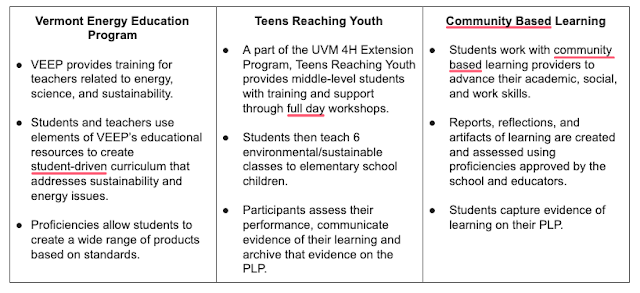PLP Pathways and Proficiency-Based Learning
In April, PLP Pathways participated in the Proficiency-Based Learning forum co-hosted by Vermont Learning for the Future and Up for Learning. The goal of the forum was aimed at elevating a strengths-based, solution-oriented dialogue about making the transition to PBL in Vermont. The forum provided PLP Pathways an opportunity to reflect on the ways that we have shared in the learning of practitioners from around the state as we work to implement proficiency-based learning and how the personal learning framework supports the shift to PBL.
Three Pillars of Personalized Learning
Personal Learning Plans (Identity/Engagement/Evidence of Growth)
Personal Learning Plans are a critical tool to help educators know students well and to help students develop and achieve clear academic and social goals in order to be productive and socially responsible citizens. The thoughtful development and implementation of PLPs engage students with a variety of learning activities and curriculum connected to their interests. This builds positive relationships with students, increases teacher understanding of students’ strengths and challenges, and provides students voice and choice in the curriculum and help to understand students’ educational aspirations.
Examples
Proficiency-Based Learning and Assessment
(Evaluating What is Most Important)
Proficiency-based learning requires that students, teachers, and families clearly understand the learning expectations and standards that students must achieve in order to be considered proficient. In addition to academic skills, proficiency-based learning systems separate academic achievement from habits of learning (transferable skills).
Key features of proficiency-based learning include the use of formative assessment, consistent and clear feedback to students, and the opportunity to retake and revise work submissions in order to achieve proficiency. Ideally, students are not measured by the time spent in class but rather their demonstration of proficiency across the curriculum. In proficiency-based learning systems, “students can demonstrate learning progress and achievement in multiple ways through differentiated assessments, personalized-learning options, or alternative learning pathways.”
Flexible Pathways
(Creating Meaningful Diverse and Equitable Learning Opportunities)
Educators must consider the skills required for students who will be moving into a high school environment with a broad range of academic opportunities available to students. Work-based learning, community internships, dual enrollment, and early college are all elements of Act 77.
Using proficiencies to monitor and assess student learning allows students and teachers to explore these learning opportunities with a common language for assessing performance. When learning expectations are clearly communicated, students, teachers, families, and extended learning providers can ensure student learning and achievement. Additionally, proficiency-based learning is a key component of effective project-based learning curriculum.


